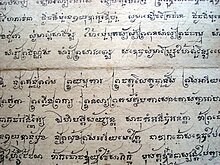Samut Khoi
Samut Khoi ( Thai : สมุด ข่อย , also: Samut Thai - สมุด ไทย ; Khoi manuscripts) are manuscripts on so-called Khoi paper that were used in Siam , today's Thailand , before the introduction of letterpress printing.
history
It is not known since when the Khoi paper was used to make books in Thailand. However, it was mentioned in 1504 by an Italian writer who stayed in Tenasserim (today: Tanintharyi Division in southern Myanmar ), which belonged to the Kingdom of Ayutthaya .
Paper making
The Khoi paper that is used for the Samut Khoi is obtained from the bark of the Khoi tree ( ข่อย , Streblus asper Lour.), A small tree or shrub from the Urtikazeen family that grows in the temperate zones of India , Thailand , Malaysia and Vietnam occurs.
The manufacture of the paper is a very laborious process that can take up to ten days.

Khoi books
The Khoi books consist of a 30 to 60 cm wide strip of Khoi paper that can be up to 18 meters (sometimes more) long. It is then folded as a leporello to a width of 12 to 20 cm. A cardboard or wooden cover is then attached to both ends to give the whole thing stability.
The "pages" of the manuscript are read horizontally. The oldest surviving specimens from the 17th century have an illustration in the middle, and the text is on the right and left. In other copies from the same period, the illustrations extend from edge to edge, often across a double page. The ink with which the words were written was obtained from lamp soot; white or yellow ink (made from arsenic sulfur) was written on black paper.
The durability of the manuscripts is amazing considering that they are prone to moisture and have been moved and folded many times. However, the precautionary measures taken in the monasteries when storing the books contribute to their durability: they are tied up and wrapped in cotton towels and stored in special cupboards. The cabinets, in turn, are located in buildings, the so-called Hor Trai , which are often built on stilts over a pond to protect against insects.
Illustrations
The illustrations are an important part of the Samut Khoi. They often fill out entire double pages, and it also happens that they continue over several folds.
The color palette is relatively small and has hardly changed over the centuries: earths (e.g. red ocher or yellow ocher ) are used, a chalk white and a black made from vegetable charcoal. Rush yellow does not seem to have been used, whereas vermilion has appeared in wall paintings since the first quarter of the 15th century. Green tones were obtained from green soil or certain plants. The different pigments were crushed in a mortar and mixed with a vegetable gum (" Feronia gum", Feronia elephantum ).
The various brushes are made from roots or certain tree bark, for example. Bristle brushes can consist of the aerial roots of the pandanus ( Pandanus tectorius ), which are cut, split and made pliable and tied into tufts. Other brushes are made from the bark of ylang-ylang (Canangium odorantum) . The finer brushes are made of hair from various animals, and hair from cow ears is used for the finest work.
Individual evidence
- ↑ a b c Jean Boisselier : Painting In Thailand . Verlag W.Kohlhammer, Stuttgart 1976, ISBN 3-17-002521-X
- ↑ Steve Van Beek: The Arts Of Thailand . Thames & Hudson, London 1991, ISBN 0-500-23620-8
Web links
- A Technical Examination of 7 Thai Manuscripts PDF with sample illustrations (in English) - last accessed on March 27, 2014

